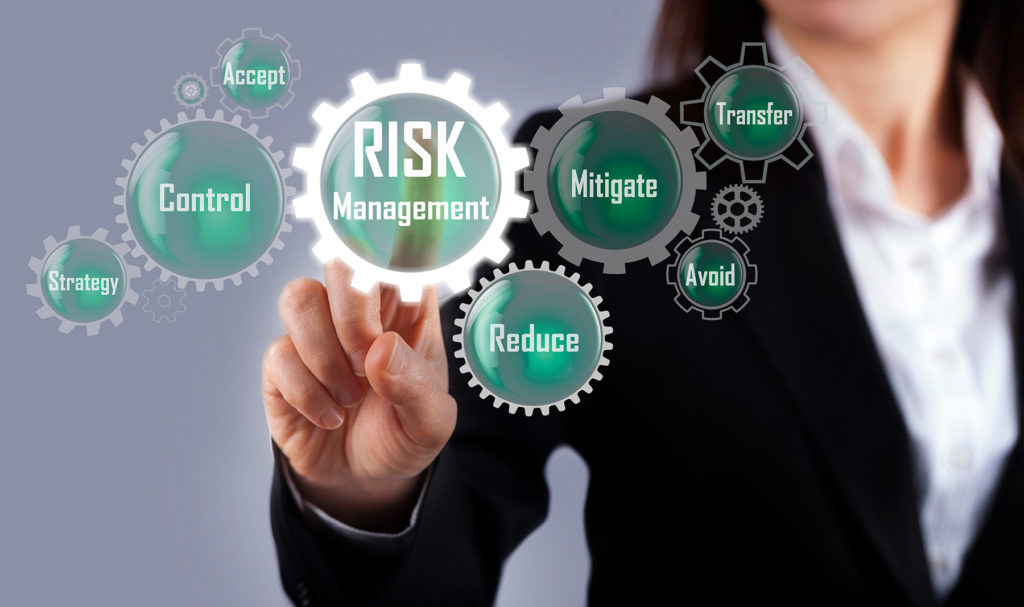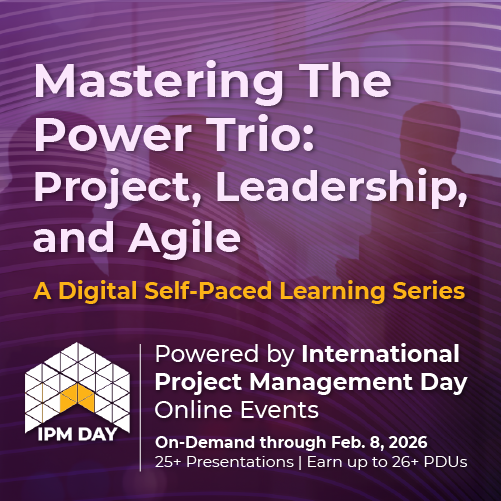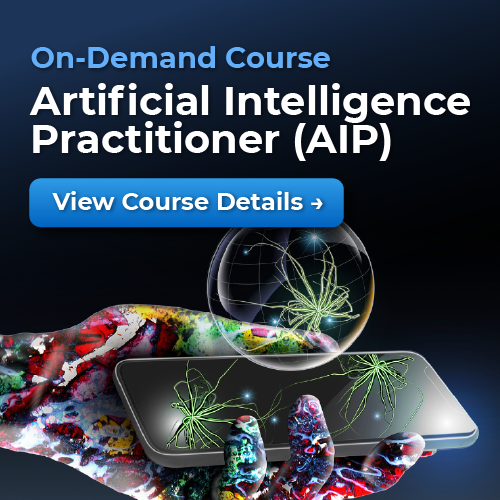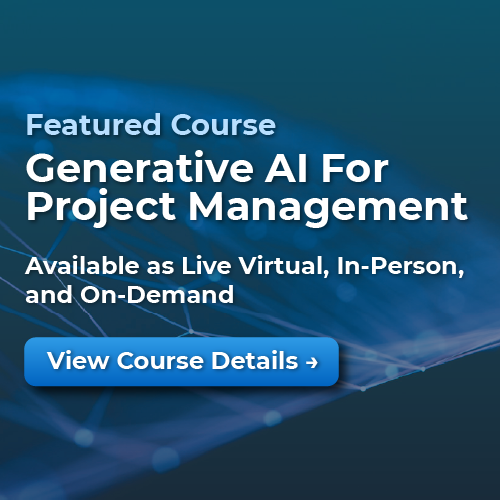By Luigi Morsa
June 9, 2022
Risk Management is the act or practice of dealing with risk. It includes planning for risk, assessing (identifying and analyzing) risk issues, developing risk handling strategies, and monitoring risks to determine how they have changed (Ref. [1]).
Risk Management is important because it is directly connected to the Project Success. More in detail, effective risk management strategies allow you to identify the project’s strengths, weaknesses, opportunities and, above all, threats. By taking into account unexpected events, you can be ready to respond if they arise (Ref. [2]). It is high unlikely to imagine a project without risks; therefore, it is better to be prepared, namely to mitigate or limit the problems that could compromise the project.
Risk Management is a complex discipline because it deals with the uncertainty, more scientifically, the risk is a measure of the probability and consequence of not achieving a defined project goal. Risk management includes several actions involving risk: planning, assessment (identification and analysis), handling, and monitoring (Ref. [1]). In this regard, the PMBOK® Guide presents a clear methodology for managing risks – from identification, through analysis to monitoring and control.
Without going into details in all phases it can be easily imagined that the more information collected about the potential uncertainties (risk identification), the more accurate the estimation can be about the likelihood and the impact of these on the project (risk analysis).
If the risk identification is not accurate, it is apparent that everything that follows can be severely compromised or wrong. The article, “Risk Identification: Combining the Tools to Deliver the Goods,” by C. Piney, presented at PMI® Global Congress in 2003 (Ref. [3]), provides us an idea about how complex is the Risk Identification phase. In the paper, a risk identification life-cycle is defined, and in it, one of the key phases is the interviewing phase. It is underlined that in order to obtain the best results from an interview, it should be run as a project in its own right: define the objectives and desired outcome. Select the correct people and brief them (interviewers and interviewees). Allocate time and resources. Develop relevant questions.
Without any doubt, as for the risk identification, the support of the employees in terms of ideas, opinions and warnings can be really useful. At the same time, it is needed to create the conditions that employees feel part of the process, willing to give their contribution or to investigate on their own about the potential risks (Be Proactive, Not Reactive).
An interesting proposal about employees’ inclusion in the risk management process is explained in an article, meaningfully entitled, “When Every Employee Is a Risk Manager,” which appeared last year (Jan. 2021) in Harvard Business Review (Ref. [4]). In the text it is described an app called RiskTalk introduced at Swissgrid, the reliable electricity network operator for Switzerland. RiskTalk makes it easy for employees to report, anonymously if they wish, any issue or hindrance that could adversely affect a corporate strategic or operational priority such as safety. The tool channels employees’ observations and concerns up to a triage team of a dozen Swissgrid managers who function as the firm’s de facto chief worry officers, ensuring that no emerging issue remains unnoticed, unanalyzed, or unaddressed.
The introduction and the use of the App above is definitely something that can facilitate the collaboration by the employees to Risk Identification. Together with the App, it is essential to give the deserved recognition to the employees who effectively contribute. This means for instance to invite the employee to some strategic meeting to define maybe together how his/her proposal can be considered. It can also even be important for future actions to understand why the proposal is rejected. In a nutshell, the company has to give the tangible perception that employees’ ideas are given consideration and where possible they are applied, and if not, at least a motivation is provided. Only in this way, the employees will develop the sense of belonging to the company that will push him/her to always give a valuable contribution. Alternatively, without noticeable attention by the company, the employee may feel ignored and therefore he/she will start to be reluctant in giving some ideas or remarks or warnings for the company. The ideal way to close the virtuous circle would be to find the way to quantify with a prize/benefit due to the positive contribution brought by the distinguished employees. This would be the sign that the success is shared.
The following waterfall chart displays all the positive implications, from the initial contribution given by employees, to the last step, where part of success (awards) is given.
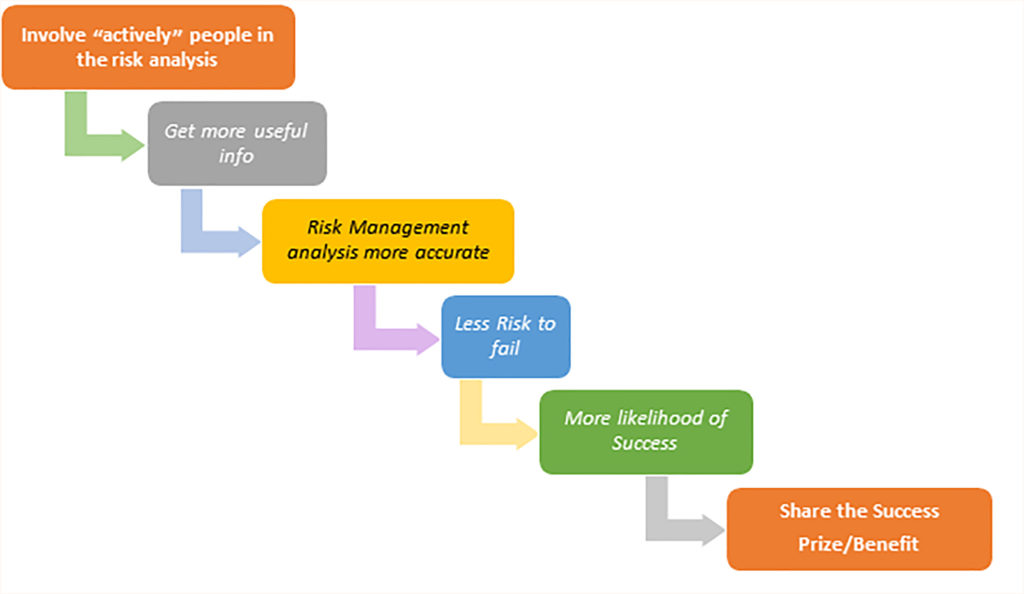
Reduce the Risk – Share the Success, Process Implications
By including the people during certain critical activities such as Risk Management or even Innovation (Ref. [5], [6]) is definitely a way to give consideration to the employees with a double positive effect. From one side, the employees will feel themselves as part of the development process of the company (feeling of decision not imposed by the top), and from another side the company will receive strategic consulting from its own workforce.
The application about Risk management discussed above can be framed also in the so-called Democratic Management (Ref. [7]). Indeed, the Democratic management shares responsibilities; even if the manager has the final say in every decision that is made, he/she asks around for input and possible solutions with the advantages, as underlined above, both for the employees and for the company.
- Edmund H. Conrow, “Effective Risk Management: Some Keys to Success”, 2nd, American Institute of Aeronautics and Astronautics, 2003.
- Tara Duggan, “Why Is Risk Management Important to Project Success?”, Houston Chronicle, Chron.com, February 19, 2019.
- Crispin Piney. “Risk identification: combining the tools to deliver the goods”. PMI® Global Congress 2003—EMEA, The Hague, South Holland, The Netherlands. Newtown Square, PA: Project Management Institute.
- Kurt Meyer, Anette Mikes, and Robert S. Kaplan, “When Every Employee Is a Risk Manager”, Harvard Business Review, January 25, 2021.
- Harold Kerzner, “Innovation Project Management”, 2nd Edition, Wiley 2022.
- Luigi Morsa, “People Innovation: A New Vision to Innovate”, International Institute of Learning (IIL) Blog, 2019.
- Anderson, R. C., “Learning in discussions: A resume of the authoritarian-democratic studies”, Harvard Educational Review, 29, 201-212, 1959.
About the Author
Luigi Morsa (Ph.D.) is an Aerospace Engineer and Project Manager working for the consultant company, SII Germany Engineering & IT. Luigi’s passion for project management has led him to contribute to two books by Dr. Harold Kerzner, the pioneer and globally recognized expert in project management. Luigi wrote two cases studies about the Aircraft industry for Project Management Case Studies, 5th and 6th Editions (Wiley, 2017, 2022) and two sections (Open Innovation in Action; The Project Manager’s Role in Developing Innovation Skills and Ideas in People) and the chapter, “Innovation Management Software” for Innovation Project Management 1st and 2nd editions (Wiley, 2019, 2022). Recently, he has written together with Richard Maltzman, PMP and adjunct professor at Clark University (Boston), the chapter, “10 Lessons Learnt from Irresponsibility in Project Management” for the book De Gruyter Handbook of Responsible Project Management (De Gruyter, 2022).
In 2018, Luigi was a speaker at the Project Management Institute (PMI®) EMEA Congress to discuss the complexity of the aircraft industry market, with particular emphasis on the relationship between product and customer needs. He is author of three article appeared on the International Institute of Learning (IIL) blog: “Managing Conflicts in Projects” (2021); “Chess and Business Strategy” (2020); and “People Innovation: A New Vision to Innovate” (2019).

